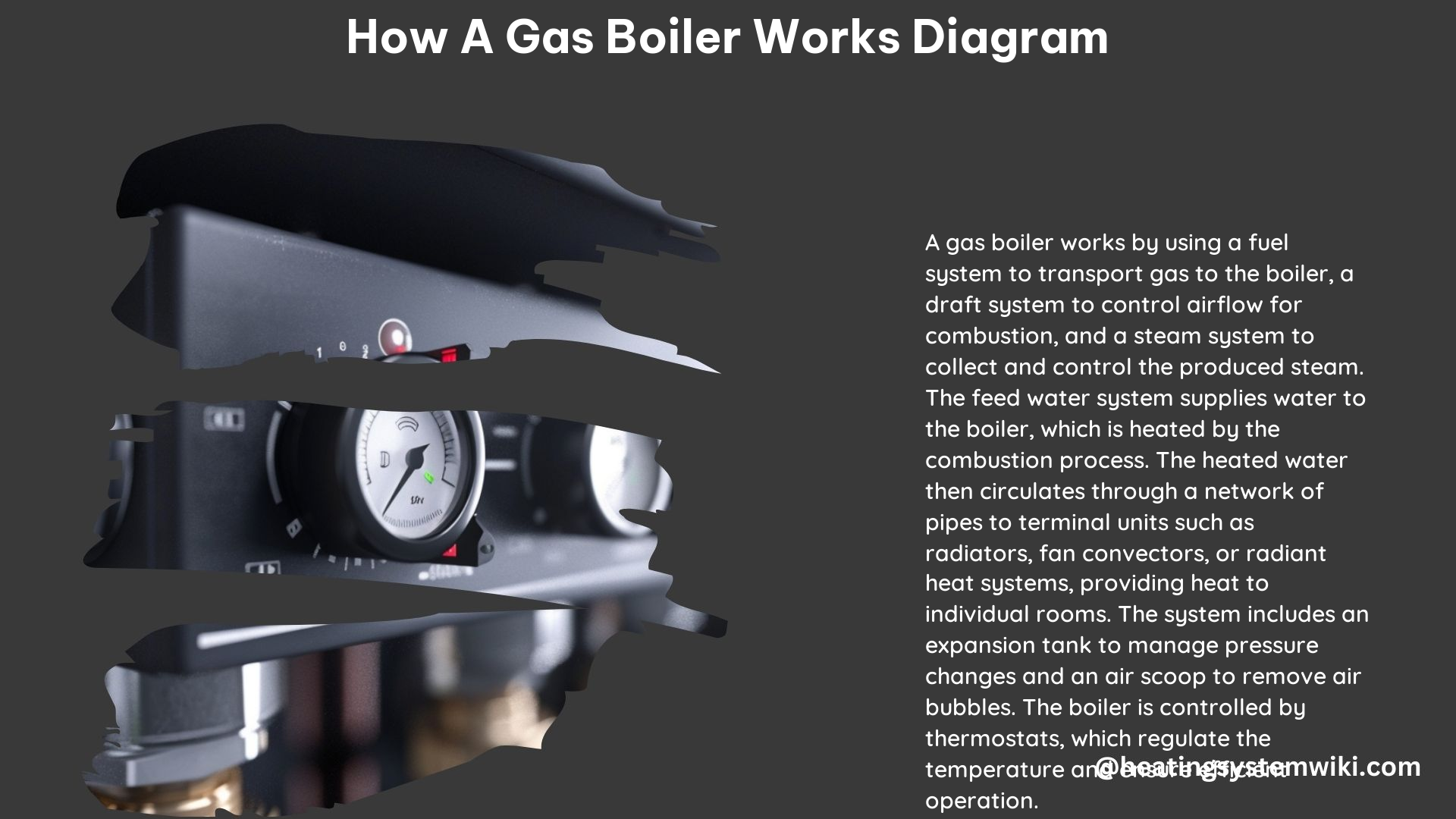A gas boiler is a central heating system that uses natural gas or propane to heat water, which is then circulated through a network of pipes to provide heat to a building. The system comprises various components that work together to efficiently convert the fuel into thermal energy and distribute it throughout the structure. This comprehensive guide delves into the intricate details of how a gas boiler operates, complete with a detailed diagram and technical specifications.
Components
-
Thermostat: The thermostat is the control center of the gas boiler system, allowing the user to set the desired temperature for the building. It communicates with the other components to ensure the desired temperature is maintained.
-
Gas Valve: The gas valve is responsible for regulating the flow of natural gas or propane to the burners. It opens and closes as needed to provide the appropriate amount of fuel for the heating process.
-
Burners: The burners are the heart of the gas boiler, where the fuel is ignited to produce heat. They are designed to ensure complete and efficient combustion, maximizing the energy output.
-
Heat Exchanger: The heat exchanger is a critical component that transfers the heat generated by the burners to the water circulating through the system. It is typically a serpentine-shaped tube that maximizes the surface area for heat transfer.
-
Pump: The pump is responsible for circulating the heated water through the primary and secondary loops of the system, ensuring the heat is distributed to the radiators or other terminal units.
-
Radiators: The radiators are the terminal units that distribute the heat to the individual rooms within the building. They can be either fan convectors or radiant heat systems, depending on the specific design of the gas boiler installation.
-
Air Scoop: The air scoop is a device that removes any air bubbles that may accumulate in the boiler line, ensuring efficient water circulation and heat transfer.
-
Expansion Tank: The expansion tank is designed to handle the thermal expansion and contraction of the water within the system, maintaining the appropriate pressure and preventing damage to the components.
Sequence of Operation

-
Thermostat: The thermostat senses the temperature in the building and calls for heat when the temperature drops below the set point.
-
Gas Valve: The gas valve opens, allowing natural gas or propane to flow to the burners.
-
Burners: The burners ignite the fuel, producing heat.
-
Heat Exchanger: The heat exchanger transfers the heat from the burners to the water circulating through the system.
-
Pump: The pump circulates the heated water through the primary and secondary loops, distributing the heat to the radiators.
-
Radiators: The radiators release the heat into the individual rooms, warming the building.
-
Air Scoop: The air scoop removes any air bubbles that may have accumulated in the boiler line, ensuring efficient water circulation.
-
Expansion Tank: The expansion tank controls the pressure changes in the system, preventing damage to the components.
Technical Specifications
- Fuel: Natural gas or propane, with a typical heating value of 1,000 BTU/ft³ for natural gas and 2,500 BTU/ft³ for propane.
- Heat Exchanger: Typically a serpentine-shaped tube made of copper or stainless steel, with a surface area of 10-20 ft² for a residential gas boiler.
- Pump: Centrifugal or positive displacement pump, with a flow rate of 5-15 gallons per minute (GPM) for a typical residential system.
- Radiators: Can be fan convectors or radiant heat systems, with a heat output of 500-2,000 BTU/h per unit.
- Expansion Tank: Designed to handle a volume expansion of 2-3% of the total system volume, with a pressure rating of 12-30 psi.
Primary-Secondary Piping
The gas boiler system utilizes a primary-secondary piping configuration to ensure efficient heat distribution:
- Primary Loop: The primary loop is the main loop that carries the heated water from the boiler to the radiators or other terminal units.
- Secondary Loop: The secondary loops are smaller loops that branch off from the primary loop to individual radiators or zones, allowing for more precise temperature control and zoning.
Combi Boiler Parts
A combi (combination) boiler is a type of gas boiler that combines the functions of heating and hot water production in a single unit. The key components of a combi boiler include:
- Heat Exchanger: The heat exchanger is designed to handle both the heating and hot water functions, efficiently transferring heat to the water.
- Pump: The pump circulates water for both the heating and hot water systems.
- Thermostats: The thermostats control the temperature of both the heating and hot water systems, allowing for independent temperature settings.
Primary-Secondary Piping Diagram
+---------------+
| Boiler |
+---------------+
|
|
v
+---------------+
| Primary Pump |
+---------------+
|
|
v
+---------------+
| Primary Loop |
+---------------+
|
|
v
+---------------+
| Secondary Loop |
+---------------+
|
|
v
+---------------+
| Radiators |
+---------------+
References:
- Alpine Intel. (2020). How A Gas Furnace Works (Animated Schematic) – YouTube. https://www.youtube.com/watch?v=n76kz1tcjtw
- Weatherization. (2011). Boiler Basics: Part III – External Components – YouTube. https://www.youtube.com/watch?v=3NVZFAcqDOk
- Mike the Boilerman. (n.d.). Central Heating Diagram. https://www.miketheboilerman.com/central-heating-diagram.html
- Alpine Intel. (2020). How a Boiler Works – YouTube. https://www.youtube.com/watch?v=ddM7z-c7sUw
- Encyclopedia of Chemical Engineering Equipment. (2022). Boilers – Visual Encyclopedia of Chemical Engineering Equipment. https://encyclopedia.che.engin.umich.edu/boilers/
